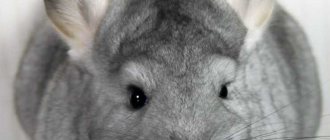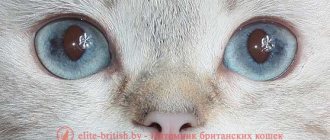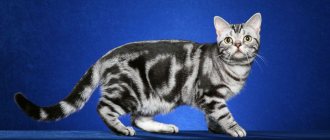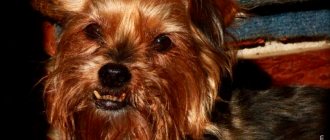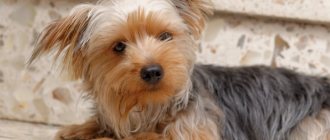Non-standard Yorkie colors
For many subspecies of standard Yorkies, the classic color is officially recognized by the FCI and the American Kennel Club (AKC). This breed was approved in the 1970s.
Initially, dogs were not considered decorative. Terriers were used to catch rodents, as Yorkies did not get along well with mice and rats.
Dogs that differ from the recognized colors are not allowed to participate in exhibitions and competitions. However, Yorkies can make excellent companions. If a client chooses dogs in a showroom for show life, he should refrain from purchasing specimens of the following colors.
- White and black terrier. As a result of a mutation in the gene that is responsible for color in Germany, black terriers with white fur were born. In 1988, a rare type of Yorkie was first introduced to the world, and was officially approved as a separate breed only in 2007. A standard was established for terriers, according to which white wool should be combined with colors:
- on the head - with a blue or golden sheen;
- on the body - with a black tint.
These individuals have good health and are not susceptible to diseases that standard terriers experience.
- The Biro Yorkie is not considered a separate breed like the Biewer Yorkie. These dogs completely lack the gene responsible for black fur. Most often these are individuals of chocolate-white and golden color. The subspecies appeared not so long ago; the Yorkie size standard has not yet been established.
- Chocolate York (Choco-York) - dog experts do not recognize the breed as ideal. Almost all of the terrier's fur is brown, shades from milk chocolate to dark bitter. The only condition is that the Yorkie's color is evenly distributed.
- Golden York (Goldusty) - found in all sorts of golden, caramel shades. Sometimes there are individuals with a white breast. Dogs with light colors may be confused with Biewers.
- Yorkie - Mermaid - a mixture of terrier with other species. They are otherwise called salon dogs. However, the appearance is very similar to Yorkies. Most often these are dogs with golden, red, and silver colors. There are individuals with white chocolate-colored fur. The coat of such terriers feels much harsher than that of the classics. Mermaids are larger in size than other dogs.
There are several more subspecies of terriers: mini-, micro-, baby Yorkies. They differ from the classic breed in size.
Standard color of the Yorkshire Terrier
Getting acquainted with information about the breed, you can immediately read that it is characterized by a dark bluish-steel color. The coat in this color composition begins to grow from the back of the head and reaches the base of the tail. The Yorkie's steel color is already a deviation. A pure shade, not mixed with bronze or red. Looking at the tan part, you will notice that the fur in this area is darker at the roots, and the middle and ends are lighter.
Based on the description, you can understand that this color is taken as the standard - blue-steel with gold. It is clear that there are many variations even with such a combination. It will be difficult to immediately determine that this is a purebred Yorkie. A photo taken from a nursery where elite (standard) representatives of the breed - those with international titles - can help. You can find photos of representatives of the breed that are close to the ideal on the Internet, but it is better to visit a dog show.
True connoisseurs of purebred Yorkies determine their eliteness by the color of the fur on the roots. If it is darker, and there is a dark blue tint along the body, while the paws and chest give off a dark brown color, then this means that this is a “real” Yorkie.
Chocolate Yorkshire Terrier
Most likely, you are ready to bet that there are many dogs with amazing colors running around the street and they are all Yorkshire terriers. Yes, that is right. All of these chocolate and golden Yorkies are considered varieties. Even an exotic color can become a sign of an exotic species. The Yorkie's color is black, white or white and black.
Thus, in Germany they raise Biewer Yorkies, which are in demand. They can be recognized by their shades of white and black, gold and light brown. The golden Yorkie was bred by Russian breeders, who nicknamed the dogs “Mermaids.”
Looking at a chocolate terrier, you understand that there is something unusual and special about him. Some people will like Biro-Yorks, which have a mixture of chocolate and white.
When you look at a Yorkie of a different color, you should understand that this is not exactly the standard. You shouldn't expect the same characteristics from it. When obtaining a new species, matings with other breeds of dogs are used, hence the different color, nuances in nutrition, behavior and care.
Recognized Yorkie colors
There is only one color of terriers allowed for exhibitions - classic.
Standard:
- The fur on a Yorkie's face should not be white, black or brown. Colors allowed: golden, dark red
- The terrier's head is small, proportionally small in comparison with the body. The nose is round and black. The eyes are not protruding.
- The ears are erect, triangular in shape, and small in size.
- The structure of the coat is straight, smooth, and silky to the touch. It is long on all parts of the Yorkie's body, flowing down.
- The collar is a similar shade as the muzzle - dark red, golden brown.
- The body and tail are exclusively with a blue steel tint.
This is interesting: DIY clothes for Yorkies
The presence of white, gray or black hairs on the body of a Yorkie is considered a flaw. The tail can be either the same shade as the fur or darker, but always with a blue tint. It also happens that the roots are darker than the tips. This is not considered a deviation.
The weight of dogs ranges between 2000-3100 g. Dogs weighing 1.5-2 kg belong to the subspecies of York Terriers - mini-Yorks. Less than this value are micro-Yorks.
Yorkie wool
This breed has no undercoat, which means Yorkies hardly shed.
By the way, their hair is similar to human : it always grows and falls out only due to mechanical stress or diseases of the Yorkshire Terrier.
The structure of the Yorkie's coat is such that it rarely causes allergies in humans. However, this dog's dander, odor, or saliva may be allergens.
The “brick” color of the Yorkshire Terrier's head should not extend to the neck or be mixed with gray or black hair.
Regarding the wool standard:
- absolutely straight, shiny, thin, no frizz;
- on the head - long, golden red-brown; brighter on the sides of the head, at the beginning of the ears and on the muzzle, where the hair is longest;
- Yorkie's coat color is steel bluish; lies from the back of the head (tubercle) to the beginning of the tail. Tan, dark or bronze hair is outside the standard;
- The color of the breast is a juicy brown-red. All these “brick” hairs darken, starting from the tips to the roots;
- Yorkie's limbs are covered in the same red-brown coat, with a golden tint. This color should not extend beyond the dog's elbows and knees;
- ears - “short-haired”, bright brick;
- The Yorkshire Terrier's tail is standard - well covered with blue hair, darker than on the body, especially at the tip of the tail.
Yorkshire Terrier Coat Types
It must be said that most Yorkies do not live up to their color standard.
There is usually a wide range of dark to light brown hairs on a dog's body. Or the base of the hair is colored black or silver-gray.
A parallel has been noted between the hair structure and color of the Yorkshire Terrier:
- in dark individuals, the coat is usually slightly wavy and fluffy;
- for light ones it is “correct”, silky, but over the years it can turn yellow.
The most difficult thing for a breeder is to get a Yorkie to have a deep, dark steel color. But it is in this shade that Yorkshire terriers have the ideal coat in terms of standard and aesthetics.
Wool length
The Yorkshire Terrier's coat reaches the standard length - to the floor - at 15-20 months.
To prevent the show Yorkie's fur from getting tangled and spoiled, it is wound onto flagella (papillots).
Before the exhibition, they are removed, and the hairs on the dog’s head are collected into a knot - a topknot (from the English “tuft”).
If the dog is not going to participate in exhibitions or has already completed its career, it is usually cut somewhat shorter. Ponytails are made on the head or bangs are cut.
What color to choose a puppy
In order not to make a mistake when choosing a Yorkie puppy that meets the standards, first of all, you need to check all the relevant documents:
- certificates from exhibitions, if any;
- complete information about the puppy's pedigree;
- certificates from the veterinary clinic with all vaccinations.
Responsible breeders are required to provide a package with these documents. If they refuse to show them or say that there are no papers, you should think about the integrity of such a seller.
It is recommended to pay attention to the conditions in which puppies grow up:
- It is worth avoiding houses where dogs are kept outside (Yorkies have poor health).
- There must be order in a shelter or nursery.
- Puppies are characterized by playfulness and liveliness, so it is advisable to look at their behavior: they should be active.
Newborn puppies slightly resemble Rottweilers. They are completely black except for small brown spots on the face. Dogs will be dark for up to 2 months, then they will begin to lighten. This is due to hormonal changes.
You can buy a puppy 4-6 months old; usually at this age it is already clear what color the mature dog will acquire. However, it will cost more, and changes can take place up to 2 years of age.
To make sure as much as possible about the future color of the puppy, you need to part the fur on its head and look: if the roots of the hairs turn golden, then, most likely, the dog will take on the correct color.
It is also advisable to pay attention to small details, such as:
- wet black nose (you can use it to determine whether the puppy is healthy);
- shiny eyes, not protruding;
- type of ears (at 3 months they should be standing).
The breeder is obliged to show how to properly trim dogs and how to care for them.
The pet is also examined for the following abnormalities:
- overly curved body;
- incorrect position of the ears;
- short or elongated muzzle;
- malocclusion, jaw problems;
- the tail is below the level of the back;
- light hairs in dark areas and vice versa;
- cryptorchidism.
And of course, it is worth examining your pet for standard deficiencies, such as deafness or blindness, or breathing problems.
Expert opinion
Anna Abramenko
An avid dog lover. Experience in veterinary medicine since 2009.
Ask a Question
Vaccinated terriers with good pedigree cannot be cheap.
How to choose?
There are so many unique variations in the Yorkshire Terrier breed that many breeders are interested in how exactly to choose a puppy.
Before getting a pet, you should carefully study the information about each subspecies in order to decide on the best option for yourself.
Like all popular decorative dogs, they need proper and systematic care. Especially in terms of wool - many breeds can be quickly neglected if you do not periodically cut and bathe the dog.
It is better to purchase puppies at 2-3 months. At this age, children should know minimal discipline, have the necessary pedigree documents and already show their temperament.
IMPORTANT!
If you are planning a show career for your pet, you should pay attention to the structure and color of the coat. It should be a rich dark color, with clearly visible tan spots of various shapes and sizes.
It is not recommended to purchase puppies with a gray-fawn shade with a bluish tint or non-standard versions, even when the owner convincingly states that the coat will change as they grow older.
“Blooming” of the coat in Yorkies occurs at 4-5 months, and the final color will be formed only by 1-2 years. Therefore, the older the puppy, the easier it will be to predict the future tone of its coat.
Grooming to enhance color
If a dog does not develop a permanent silver color on its back before 10 months and remains black, you should not hope for the appearance of a steel tint. However, prolonged exposure to the sun can cause the fur to burn out and fade.
The unexpected appearance of gray hair in a grown individual does not mean that the Yorkie's colors are taking on the desired color. Instead of entering your pet into competitions, you should immediately contact a veterinarian, as this could be the beginning of a serious illness or a lack of zinc in the body.
This does not mean that the coat does not need to be looked after - Yorkies need constant care. Terriers need frequent bathing and haircuts every 2-3 months.
If the dog does not participate in exhibitions, it is not recommended to keep a long coat, as it can get tangled and dirty. Particularly in need of a short haircut are the belly, tail, back and genitals.
Show dogs are usually not trimmed in the specified places, however, they need more supervision: when walking, you should dress your Yorkie in overalls, and wrap their hair in curlers between shows.
Expert opinion
Anna Abramenko
An avid dog lover. Experience in veterinary medicine since 2009.
Ask a Question
Because of the long locks, debris gets into your Yorkie's eyes. To avoid diseases, the hair from the muzzle is removed in curlers and the eyes are wiped with a clean swab every day.
Help in choosing the right color puppy
If you see a Yorkshire Terrier puppy for the first time, you may not immediately believe that it is a Yorkie. Black Yorkshire Terrier - Puppies of this breed look more like Rottweilers than adult Yorkies. They are born black with golden tan marks .
Important! The location of these bright spots matters. In order for the baby to change to a standard color, the spots can be on the animal's face, the front of all four legs, on the inside of the front legs and under the tail.
If a chocolate-colored Yorkshire Terrier has spots of brown, chocolate, or coffee shades, then she will never acquire a standard color. The structure of the hairline is also of great importance - the hair should not look like cotton wool or be too hard.
If you want a dog for a show, you can use the following tips:
- One -month-old puppies have golden hairs on their heads, at the very base. This can be seen by spreading the fur. This means it will bloom to the desired shade. Combined with silky-feeling wool, this is an ideal specimen.
- At the age of 5 months, the hairs become stiffer , the ears, muzzle, and paws change color.
- By 9-10 months it will become clear whether the back will be steel-colored . If the black color does not go away, then the puppy is not suitable for breeding. And if the fur softens, and the shoulders and neck begin to lighten , then you should expect a good coloring of the pet. The brown-golden color on the paws and ears is bright at this age.
- Healthy hair is shiny and does not frizz or frizz.
Advice! When choosing an expensive purebred dog, you should pay attention to the presence of a brand, general condition, eyes, ears, vigor and agility. The standard is not silver or light at 4-6 months of age.
Color change with age
Puppies begin to change hair color on their muzzle, paws and chest . This happens at any young age, even if the baby is only a month old. Black fur begins to disappear from the body, neck, lower back, and croup. By 11 months or a year, the Yorkie should be approximately the same color as an adult dog . There should be no interspersed hairs of a different color on the back and no bronze spots throughout the body.
Conclusion
Before you decide to get a Yorkshire Terrier, it is advisable to weigh the pros and cons.
Pros:
- York Terriers are loyal, intelligent creatures. They are active, playful, determined, and do not require daily walking, as they can be trained to use a litter box at home;
- the breed is considered hypoallergenic;
- dogs do not shed and do not have an unpleasant odor.
The disadvantages include:
- need for special care;
- additional expenses for purchasing clothes (shoes are even recommended in winter);
- high price;
- poor health. Terriers are prone to colds and have fragile bones.
The owners note that these dogs make excellent household members. They get along well with other animals and do not take up much space. Sometimes Yorkies can be capricious, but they have a good-natured character.
Useful video
We recommend that you familiarize yourself with the video and photos to clearly recognize and see the lovely Yorkshire terriers.


